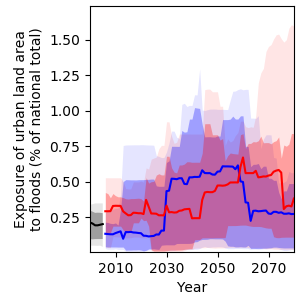Chad: Infrastructure
Climate change is expected to significantly affect Chad’s infrastructure sector through extreme weather events, such as flooding and heatwaves. High precipitation amounts can lead to flooding of roads, while high temperatures can cause roads, bridges and protective structures to develop cracks and degrade more quickly. The absence of railways, seasonal navigability of rivers and limited airport facilities increase Chad’s reliance on road transportation [30]. The country’s road density ranges from 40.5 km per 1 000 km2 in the south to only 6.4 km per 1 000 km2 in the north, making it one of the lowest on the continent [30]. Many unpaved roads become impassable during the rainy season, cutting off villages and rural communities [30]. Investments will have to be made to build climate-resilient road networks.
Extreme weather events will also have devastating effects on human settlements and economic production sites, especially in urban areas with high population densities like N’Djamena, Moundou or Sarh. Informal settlements are particularly vulnerable to extreme weather events: Makeshift homes are often built in unstable geographical locations including river banks, where flooding can lead to loss of housing, contamination of water, injury or death. Dwellers usually have low adaptive capacity to respond to such events due to high levels of poverty and a lack of risk-reducing infrastructures. In 2012, heavy floods in southern Chad affected up to 700 000 people [31], with the most affected regions being Tandjilé, Mayo-Kebbi Est, Mayo-Kebbi Ouest and Sila [32]. At least 255 000 hectares of cropland and 96 000 houses were destroyed [32].
Despite the risk of infrastructure damage being likely to increase, precise predictions of the location and the extent of exposure are difficult to make. For example, projections of river flood events are subject to substantial modelling uncertainty, largely due to the uncertainty of future projections of precipitation amounts and their spatial distribution, affecting flood occurrence (see also Figure 4). In the case of Chad, projections show an increase in the exposure of major roads to river floods from 1.4 % in 2000 to 2.2 % by 2080 under RCP6.0. Under RCP2.6, projections indicate an increase towards mid-century but no overall change by 2080 (Figure 12). Exposure of urban land area to floods is projected to not change under RCP2.6 and to increase slightly under RCP6.0, from 0.2 % in 2000 to 0.4 % in 2080 (Figure 13).


While three out of four models project an increase in the exposure of the GDP to heatwaves, its magnitude is uncertain, with one model projecting strong and two models projecting more moderate increases. Median model projections for RCP2.6 show an increase from 2.2 % in 2000 to 8.0 % by 2080. Under RCP6.0, exposure is projected to rise to 14 % over the same period (Figure 14). It is recommended that policy planners start identifying heat-sensitive economic production sites and activities, and integrating climate adaptation strategies, such as improved, solar-powered cooling systems, “cool roof” isolation materials or switching the operating hours from day to night [33].

References
[30] Logistics Cluster and WFP, “Chad Logistics Infrastructure,” 2020. Online available: https://dlca.logcluster.org/display/public/DLCA/2+Chad+Logistics+Infrastructure [Accessed: 27-Apr-2020].
[31] OCHA, “Humanitarian Bulletin: Chad (January 2013),” N’Djamena, Chad, 2013.
[32] OCHA, “Chad: Humanitarian Snapshot (24 September 2012),” N’Djamena, Chad, 2012.
[33] M. Dabaieh, O. Wanas, M. A. Hegazy, and E. Johansson, “Reducing Cooling Demands in a Hot Dry Climate: A Simulation Study for Non-Insulated Passive Cool Roof Thermal Performance in Residential Buildings,” Energy Build., vol. 89, pp. 142–152, 2015.


